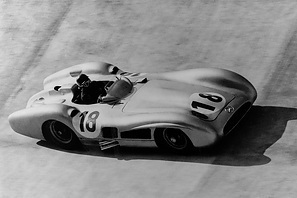The streamlined version of the W 196 R was only used once in the 1955 season: in the final race, the Italian Grand Prix at the Autodrom in Monza on 11 September 1955. The streamlined car was able to demonstrate its advantages particularly well on the high-speed circuit there with its newly designed, steeply banked curves. The W 196 R was extensively revised for its second racing season, with the development focussing on increasing performance on the one hand and reducing weight on the other. Different wheelbases were also experimented with, all of which were tested in racing.
The streamlined car was not only used with the regular wheelbase of 2350 mm, but also in a version with a shortened wheelbase of 2210 mm. Three cars of this version were prepared for the Italian Grand Prix and tested on site three weeks before the race; various modifications to the front section were also tried in order to increase downforce on the front axle. However, in addition to two classic monoposti with open wheels, only two streamlined cars with a regular wheelbase entered the race, after the short version had shown unsatisfactory road holding in practice. A variant equipped with air brakes along the lines of the 300 SLR was also tested, but was also not used for racing.
For the 1955 season, both body versions of the W 196 R were fitted with a more powerful engine. The key measure of the performance upgrade was the use of a straight intake manifold instead of the previously curved version. As a result, power output was increased by almost 13% to 290 hp/213 kW at 8500 rpm.
The changeover to the straight intake manifold was also the reason for the externally recognisable differences in which the 1955 streamlined car stood out from the previous year's version. However, these only became apparent in individual details on closer inspection. The straight intake manifold required more installation space at the top compared to the previously used curved version: As a result, the bonnet of the streamlined car was no longer symmetrical, but had a bulge for the intake manifold on the right-hand side. The intake of combustion air was now separate from the cooling air intake and took place via a grille at the front of the bulge required for the straight intake manifold.
The large cooling air intake also had a framed wire mesh. It was designed to prevent leaves and scraps of paper from entering the vehicle and could be opened by the driver using a pull lever, whereby the accumulated objects were blown away by the airflow. There were further differences in the details of the bodywork, particularly with regard to the position and design of the cooling air openings and exhaust pipes. The latter now both emerged from the body in the sill area on the right-hand side, while the upper side opening was now used exclusively for cooling air extraction from the engine compartment. The openings below the windscreen, which had previously been used to supply cooling air to the inboard rear brakes, were no longer required: Their task was taken over by closable flaps on the left and right of the windscreen base.
With the aforementioned modifications, the streamlined car completed its only race of the 1955 season with flying colours: Although only one of the two cars finished the Italian Grand Prix in Monza, Fangio saved the team's honour with a victory after Stirling Moss retired. Second place went to the Italian Piero Taruffi, who had already been hired by racing director Alfred Neubauer for the British Grand Prix. He started the race in a classic monoposto with open wheels. Juan Manuel Fangio, the winner of the Italian Grand Prix, was able to defend the title he had won the previous year and also won the 1955 World Championship. His team-mate Stirling Moss was the runner-up in the world championship.


